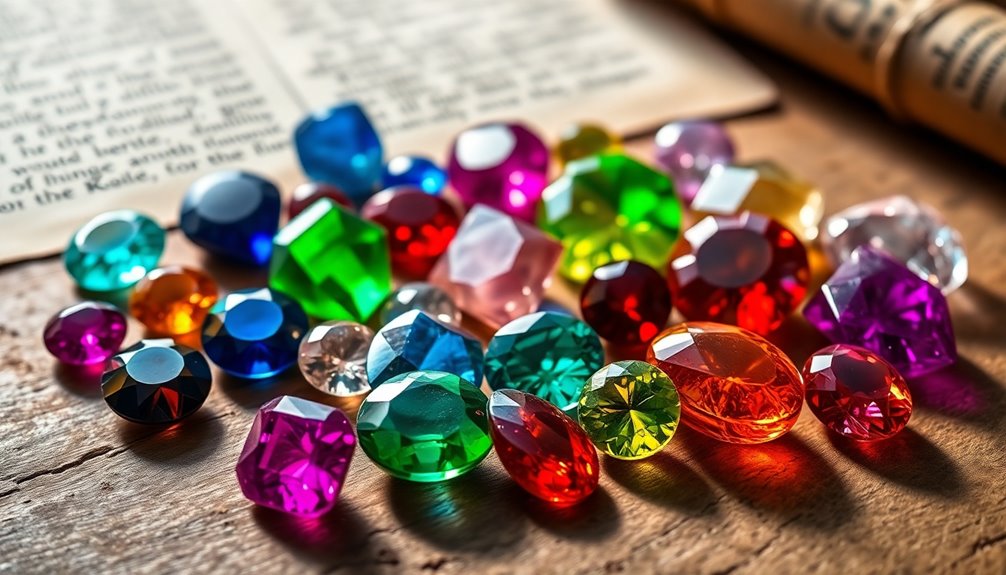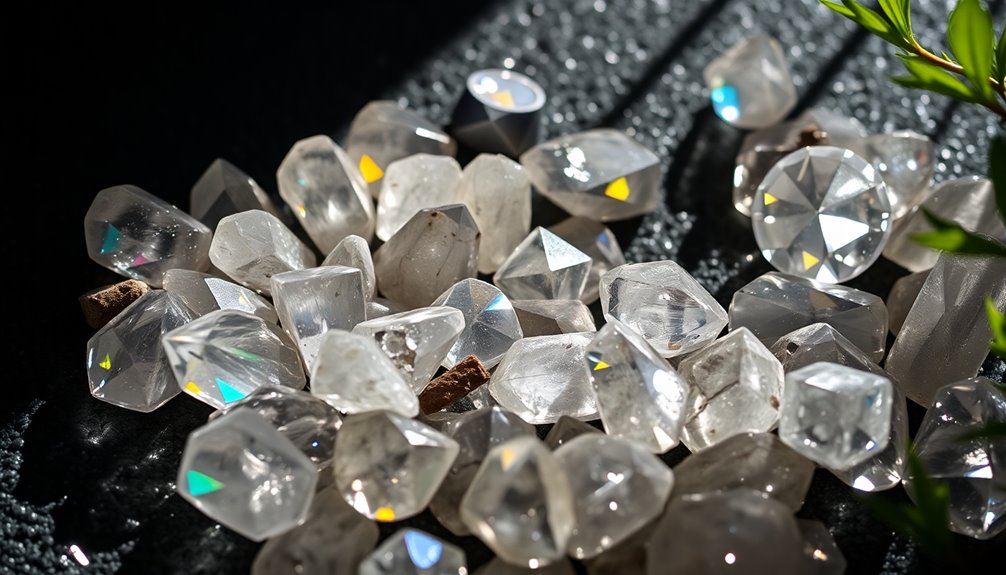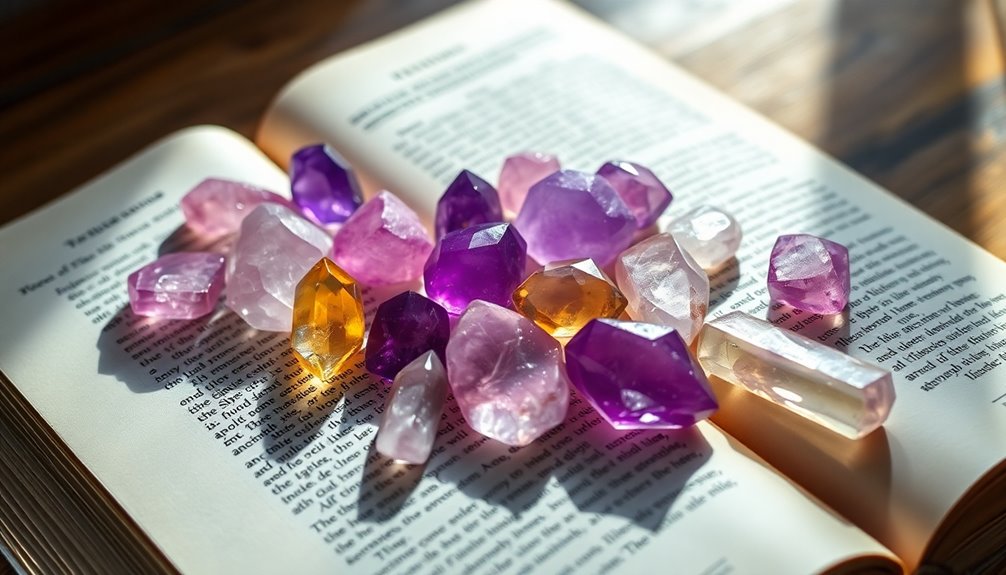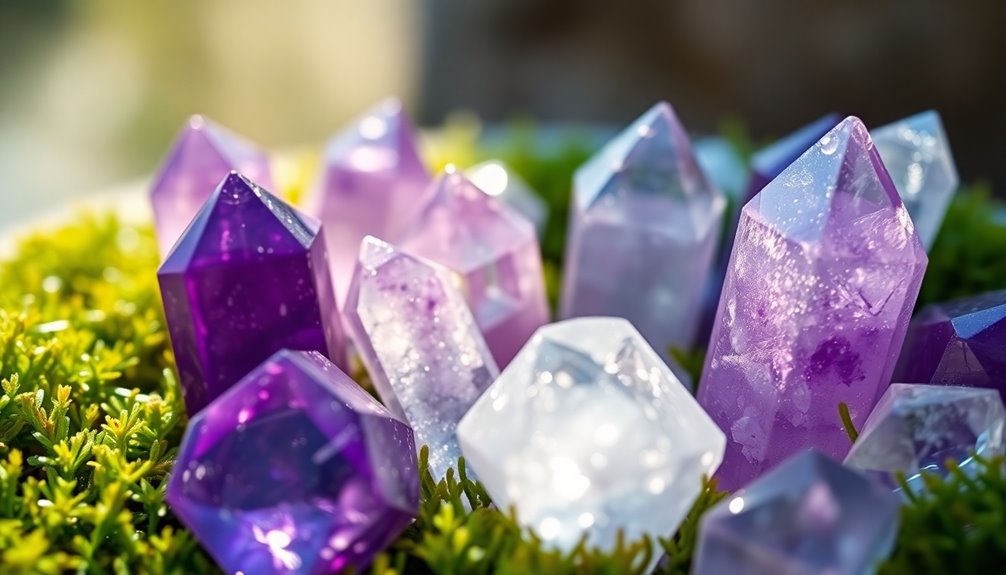The Bible mentions crystals mainly as beautiful parts of God's creation, highlighting their aesthetic value rather than any mystical qualities. You'll find references to precious stones in contexts like the high priest's breastplate, which symbolizes God's covenant with His people (Exodus 39:10-13). While these gems signify beauty and divine presence, they aren't seen as tools for healing or charms. Instead, the scriptures encourage relying on God for guidance and healing (Psalm 103:2-4). Understanding this can give you a deeper appreciation for the biblical perspective on crystals and their intended significance.
Key Takeaways
- The Bible mentions crystals primarily for their beauty and aesthetic value, as seen in the high priest's breastplate (Exodus 39:10-13).
- Precious stones symbolize God's glory and craftsmanship, particularly in the description of the New Jerusalem (Revelation 21:18-21).
- Crystals do not possess supernatural powers; their beauty serves as a reminder of God's creative genius (Job 28:17, Proverbs 8:11).
- The Bible emphasizes reliance on prayer and faith for healing and guidance rather than on crystals or mystical practices (Psalm 103:2-4).
- Historical and ceremonial uses of crystals in the Bible underscore their significance without attributing magical qualities (Ezekiel 28:13).
Introduction

When exploring what the Bible says about crystals, it's essential to recognize their significance within a biblical context. The Bible mentions various crystals and gemstones, like rubies, sapphires, and topaz, highlighting their beauty and value. These beautiful creations of God are often associated with the high priest's breastplate, which contained twelve stones representing the tribes of Israel. This demonstrates their importance in biblical tradition, focusing on their decorative role rather than attributing them mystical or healing properties.
In Revelation 21, the New Jerusalem is adorned with precious stones, symbolizing God's glory and craftsmanship. This imagery emphasizes that while crystals are aesthetically pleasing, their spiritual significance isn't tied to occult practices.
The Bible warns against using crystals for charms or in any idolatrous manner, categorizing such actions as contrary to faith in God. Crystals shouldn't be seen as tools for healing or spiritual enhancement; instead, they serve as reminders of God's creative beauty in the world.
Scriptural Insights on Crystals

When you look at the Bible, you'll find numerous references to crystals and gemstones that highlight their beauty and significance.
From the high priest's breastplate to the description of the New Jerusalem, these stones serve symbolic purposes rather than mystical ones.
Understanding these scriptural insights can help you appreciate the role of crystals in a biblical context.
Primary Bible References
Numerous references in the Bible highlight the beauty and significance of various precious stones, including rubies, sapphires, and topaz. For instance, Proverbs 8:11 values wisdom over rubies, while Lamentations 4:7 describes the splendor of sapphires. In Exodus 39:10-13, the high priest's breastplate features twelve stones, each symbolizing a tribe of Israel, showcasing their ceremonial importance.
However, it's essential to note that the Bible doesn't attribute any mystical or healing properties to crystals. Job 28:17 emphasizes that while precious stones are beautiful creations, they possess no inherent power. Instead, their role appears to be more about symbolizing God's glory and brilliance, especially as depicted in Revelation 21:18-21, where the New Jerusalem is adorned with these precious stones.
Moreover, the Bible warns strongly against practices that resemble divination or occult behavior. Deuteronomy 18:10-12 cautions against using amulets and charms, indicating that engaging in such practices aligns with occult practices.
Consequently, while appreciating the beauty of crystals, one should be mindful of their potential spiritual implications and the warnings found in scripture.
Secondary Bible References
Throughout the Bible, references to precious stones provide deeper insights into their significance, often linking them to themes of beauty, value, and divine presence. For example, the high priest's breastplate in Exodus 39:10-13 features twelve precious stones, each representing the tribes of Israel and symbolizing God's covenant with His people. This showcases the beauty and importance of these crystals in a sacred context.
In Revelation 21, the New Jerusalem is adorned with precious stones, illustrating God's glory and craftsmanship. This imagery emphasizes the aesthetic value rather than any alleged healing properties.
Similarly, Ezekiel 28:13 highlights the beauty and splendor of precious stones in the context of the King of Tyre, but it doesn't attribute any magical qualities to them.
While the Bible acknowledges precious stones and their beauty, it clearly avoids endorsing their use in occult practices or attributing supernatural healing properties to them. The biblical references focus on symbolism and divine presence rather than mystical powers associated with crystals.
Understanding these insights helps clarify the biblical perspective on crystals and their true significance.
Ancient Gemstone Symbolism

Gemstones in the Bible carry rich symbolism that reflects beauty, value, and divine purpose. In ancient times, gems like topaz, rubies, and sapphires were celebrated for their striking beauty and significance. The high priest's breastplate, described in Exodus 39:10-13, featured twelve precious stones, each representing a tribe of Israel. This not only symbolized unity among the tribes but also highlighted God's covenant with them.
Moreover, Revelation 21:18-21 presents the New Jerusalem adorned with various precious stones, illustrating the glory of divine creation. These gemstones aren't just decorative; they embody purity and brilliance, showcasing the splendor of God's handiwork.
Ezekiel 28:13 discusses the King of Tyre, emphasizing how these precious stones signified power and beauty in ancient culture.
While some may associate crystals with mystical or healing powers, the Bible focuses on their representation of divine beauty and purpose. Each gemstone serves as a reminder of God's creative genius and the importance of unity among His people.
Biblical Symbolism of Gemstones

How do gemstones in the Bible convey deeper meanings beyond their aesthetic appeal? Gemstones serve as profound symbols of beauty and value, reflecting God's handiwork in creation.
For instance, the breastplate of the high priest, detailed in Exodus 39:10-13, features twelve specific gemstones, each representing a tribe of Israel. This highlights the spiritual symbolism of unity and divine purpose among God's people.
In Proverbs 8:11, wisdom is described as more precious than rubies, emphasizing the idea that true value transcends material wealth. Lamentations 4:7 likens the nobility of princes to sapphires, reinforcing the connection between gemstones and elevated status.
Moreover, the New Jerusalem is depicted in Revelation 21:18-21 as resplendent with precious stones like jasper, sapphire, and emerald, symbolizing God's glory and brilliance.
While crystals and gemstones are often admired for their beauty, the Bible invites you to see them as reminders of divine creation and the greater spiritual truths they represent.
Rather than focusing on mystical properties, consider how these gemstones reflect the richness of faith and the extraordinary craftsmanship of the Creator.
Crystals and Spiritual Practices

When it comes to crystals and their supposed spiritual benefits, it's important to be skeptical of common misconceptions.
Many people attribute mystical powers to crystals, but the Bible doesn't support this belief and emphasizes reliance on God instead.
Let's unpack the reasons why crystals mightn't hold the efficacy that some claim.
Debunk Common Crystal Misconceptions
Many people mistakenly believe that crystals possess mystical or healing powers, but this notion isn't supported by biblical teachings. The Bible highlights that the beauty of crystals is part of God's creation, not sources of spiritual power (Job 28:19, Proverbs 8:11).
Misconceptions like the ability of crystals to align chakras or ward off negative energy are pseudoscientific and lack credible evidence.
Using crystals as charms or amulets for protection or good fortune aligns with practices condemned in the Bible, which warns against engaging in occult activities (Deuteronomy 18:10-12).
Historical references to crystals, such as those in the high priest's breastplate, showcase their significance in ceremonial contexts rather than personal spiritual practices (Exodus 39:10-13).
Instead of relying on crystals, Christians are encouraged to turn to prayer and faith in God for healing and guidance (Psalm 103:2-4).
Skepticism About Crystal Efficacy
Skepticism about crystal efficacy often stems from a lack of scientific evidence supporting their supposed spiritual benefits. Many claims regarding the healing properties of crystals aren't backed by credible studies, leading to the conclusion that any perceived benefits might simply be the placebo effect.
As a Christian, it's essential to remember that genuine healing comes solely from God, as highlighted in Psalm 103:2-4. The Bible warns against seeking supernatural assistance through crystals, which can be linked to occult practices, as stated in Deuteronomy 18:10-12.
These practices often align with pagan beliefs in sorcery and divination, which the scripture categorizes as detrimental to spiritual well-being. Instead of relying on crystals, Christians are encouraged to turn to prayer and scripture for their spiritual needs.
Seeking healing and guidance through these means reinforces the belief that God is the ultimate source of power and healing. By focusing on faith and divine connection, you can avoid the pitfalls of placing trust in objects that lack scriptural support and may draw you into questionable practices.
Meditation With Healing Stones

If you're considering incorporating healing stones into your daily meditation practice or joining a group session, it's essential to reflect on the biblical perspective.
While many believe these stones can enhance focus and emotional balance, the Bible encourages a different approach to meditation.
Instead of relying on crystals, you might find greater peace by meditating on scripture and deepening your relationship with God.
Daily Crystal Meditation Practice
A daily crystal meditation practice can transform your mindfulness routine and enhance your emotional well-being. By incorporating healing crystals like amethyst for tranquility and rose quartz for love, you can elevate your meditation experience.
Start by cleansing your crystals to remove any negative energy, then set a clear intention for your practice.
During your meditation, hold the crystals in your hands, place them on specific chakra points, or arrange them around your space. This helps amplify your focus and energy, allowing you to connect more deeply with their unique vibrational qualities.
Many individuals report heightened feelings of calmness and clarity, which they attribute to the powerful energies of the crystals.
To reap the full benefits, it's essential to establish a consistent routine. Dedicate just a few minutes each day to connect with your crystals, reflect on your personal intentions, or recite affirmations.
This daily practice not only enhances your meditation but also aligns your energy with the healing properties of the crystals.
While the Bible doesn't specifically address crystals, you can explore their potential to support your spiritual journey and emotional health.
Group Crystal Meditation Sessions
Group crystal meditation sessions frequently create a powerful environment for participants to connect with both each other and the healing energies of the stones. In these sessions, practitioners often use specific crystals like amethyst for tranquility or rose quartz for love to enhance the collective intention.
Guided meditations help you focus on the energy of the crystals, promoting relaxation, mindfulness, and emotional healing.
Typically, crystals are arranged in a circle or grid formation, believed to amplify the group's meditative experience. As you set personal intentions, you'll find that the energy of the crystals can support and elevate these goals.
This shared space fosters community, allowing participants to engage in meaningful discussions about their insights and feelings.
Final Thoughts on Crystals

As you reflect on the role of crystals in a biblical context, it's important to recognize their beauty as part of God's creation while steering clear of any misconceptions about their powers. The Bible mentions crystals like rubies and sapphires, celebrating their beauty and significance in divine creation (Proverbs 8:11). However, these mentions don't attribute any mystical or healing properties to them.
Crystals served ceremonial purposes, notably in the high priest's breastplate, but this use doesn't endorse their magical or healing capabilities (Exodus 39:10-13). Scripture warns against the occult, including the use of crystals for protection, which can lead to idolatry (Deuteronomy 18:10-12).
Instead, the Bible encourages you to seek healing and guidance from God through prayer and scripture (Psalm 103:2-4).
While it's tempting to rely on crystals for spiritual needs, the biblical perspective advises you to appreciate their beauty without attributing special powers to them. Embrace the divine creation of crystals, but remember that true healing and guidance come from God alone, not from objects or practices that might divert your faith.
Additional Resources

To dive deeper into the biblical perspective on crystals, consider exploring a variety of resources that clarify their significance and role in Scripture.
Books on biblical gemstones can provide insights into how crystals, like those in the high priest's breastplate, symbolize God's beauty and craftsmanship. You'll find references to stones such as rubies and sapphires, which highlight their value in biblical texts.
Additionally, resources that examine Revelation 21:18-21 will help you understand the portrayal of the New Jerusalem, adorned with precious stones that reflect God's glory.
However, be cautious of materials that promote crystals for mystical healing or occult practices, as the Bible warns against these in Deuteronomy 18:10-12.
Instead, focus on literature that emphasizes faith in God and His creations rather than attributing any supernatural properties to crystals.
Frequently Asked Questions
What Does Christianity Say About Crystals?
When you explore what Christianity says about crystals, you'll find that many Christians appreciate their beauty but caution against attributing any spiritual significance to them.
The focus should be on God rather than created objects. Some view using crystals for healing or protection as idolatrous, emphasizing reliance on faith and prayer instead.
Ultimately, while enjoying their aesthetic appeal, it's vital to remember that true guidance and healing come from God alone.
Who in the Bible Wore Crystals?
In the Bible, the high priest of Israel wore a breastplate adorned with twelve stones, including crystals like emerald and sapphire, representing the twelve tribes.
You'll also find that the King of Tyre was described as being adorned with precious stones, showcasing wealth and beauty.
Additionally, the New Jerusalem in Revelation is depicted with walls made of various precious stones, emphasizing their significance throughout biblical texts.
What Does God Say About Chakras?
God doesn't specifically mention chakras in the Bible, as they're rooted in Eastern philosophies rather than Christian beliefs.
You're encouraged to seek spiritual guidance through prayer and scripture instead of focusing on energy centers.
The Bible emphasizes a relationship with God and the Holy Spirit for spiritual health.
Engaging in practices like chakra alignment might divert you from relying on God's teachings, which prioritize faith over metaphysical concepts.
What Is the Spiritual Belief of Crystals?
Many people believe crystals have spiritual energy and healing properties.
You might find that practitioners use them for meditation, aiming to align chakras or enhance emotional well-being.
Each stone is thought to carry unique vibrations, helping you set intentions or promote healing.
While these beliefs are popular in various cultures, it's essential to consider the lack of scientific evidence backing these claims.
Ultimately, your journey with crystals is personal and can be meaningful.










